Label Switching
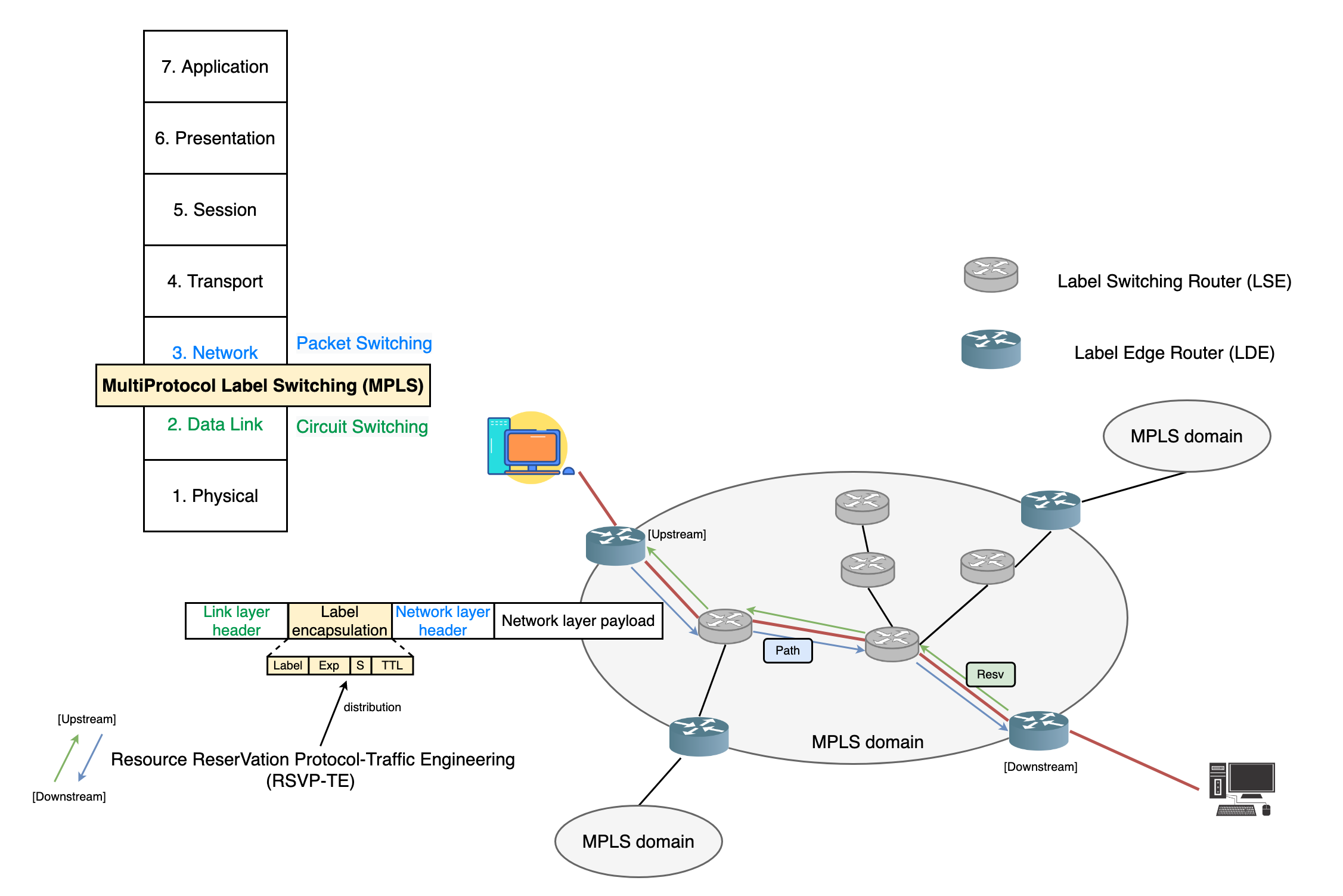
Summary of Label Switching
Motivation
Issues related to IP based routing
Lookup is rather complex
- Longest matching prefix high performance forwarding needed
Shortest path routing selects shortest path to destination
- Multiple paths to destination can not be utilized concurrently traffic engineering desirable
Strictly packet based
- Each IP datagram is handled individually – no support for data streams (flows) 🤪
Flows
What is a flow?
A flow is a sequence of packets traversing a network that share a set of header field values.
Different levels of granularity possible, e.g.,
- All packets belonging to a particular TCP connection
- HTTPS traffic
- VoIP traffic
- Of a particular sender
- Within a network
Example
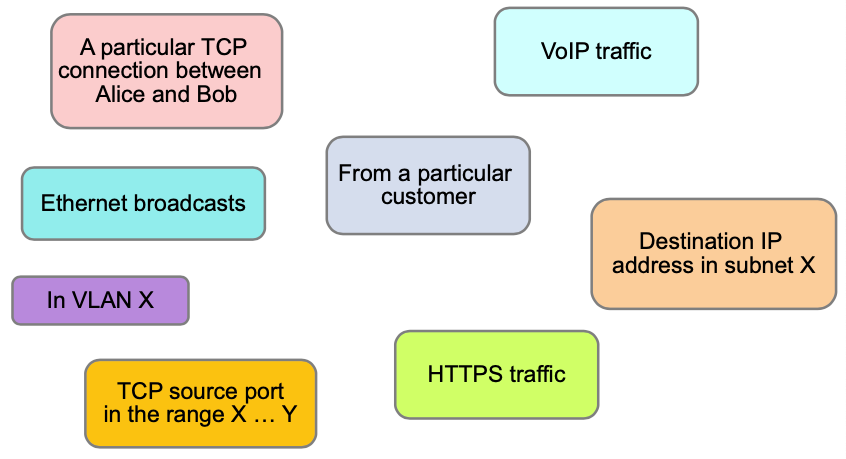
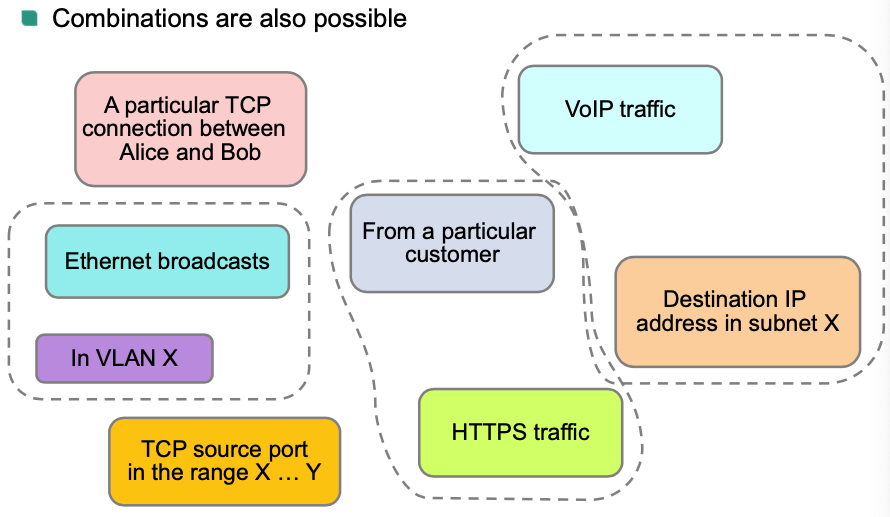
Flow Based Forwarding
- Fundamental concept, independent of certain layers
- Can span multiple layers
- Incorporates classic routing/forwarding concepts
- Goes beyond classic concepts
Aggregation
Micro-flows
Consider a single “connection” e.g., a TCP connection
Fine grained control
High number of flows possible
Macro-flows
Higher level of aggregation
Aggregation of several “connections”
- e.g., IP destination address in specific subnet
Lower number of flows
Label Switching
Classification of Communication Networks
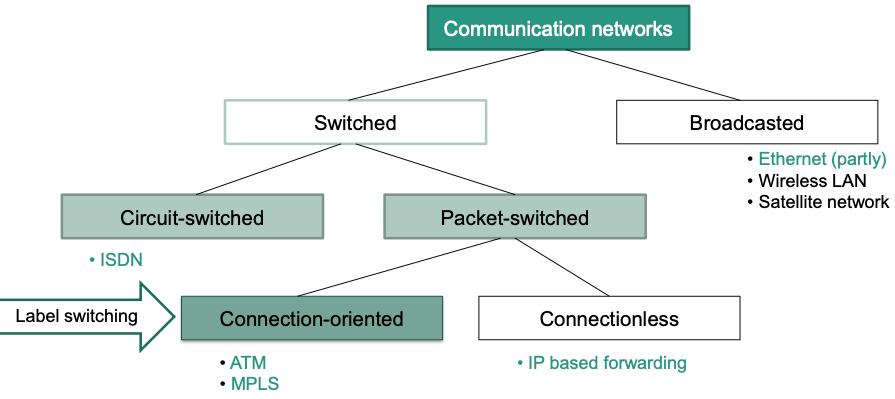
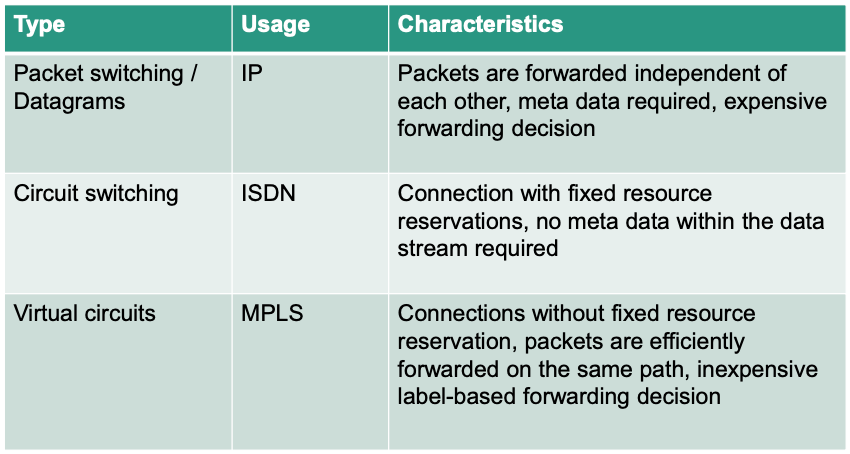
Label Switching
Combination of
Packet switching
Packets are forwarded individually (data path is NOT fixed)
Packets include metadata needed for forwarding decision
Circuit switching
Paths established for flows through the network (data path is fixed)
Simple forwarding decision
Differentiation of flows possible
- Load balancing
- Quality of service (QoS)
Implementation
- Switching at layer 2, Instead of routing at layer 3
- Labels: Identification which is only locally valid
- Virtual circuits: Sequence of labels
Label
- Short unstructured identification of fixed length
Does NOT carry any layer-3-information
Unique: only locally at the corresponding switch
Label swapping: Mapping from input label to output label
- Virtual circuit: Identified through sequence of labels at the path
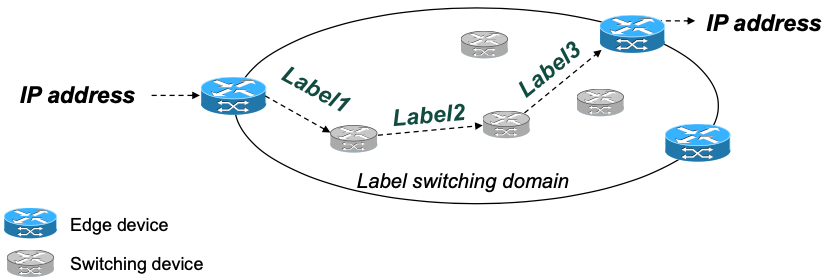
Transport of Label
Label must be transported within the packet
Additional „header“ in the packet, between headers of layer 2 and layer 3 layer 2.5

Alternative: In specialized fields within existing packet headers
- IPv6: flow label (20 bit field in IPv6 header, to identify micro flows more easily)
Label Switching Domain
Basic architecture
- Border of the domain (edge devices)
Add / remove label
Map flow to forwarding class
Access control
…
- Within the domain (switching device)
- Forward packets based on label information
- Label swapping

Label Forwarding Information Base
Forwarding table in case of label switching: Efficient access through label (NO longest prefix matching needed).
Example:
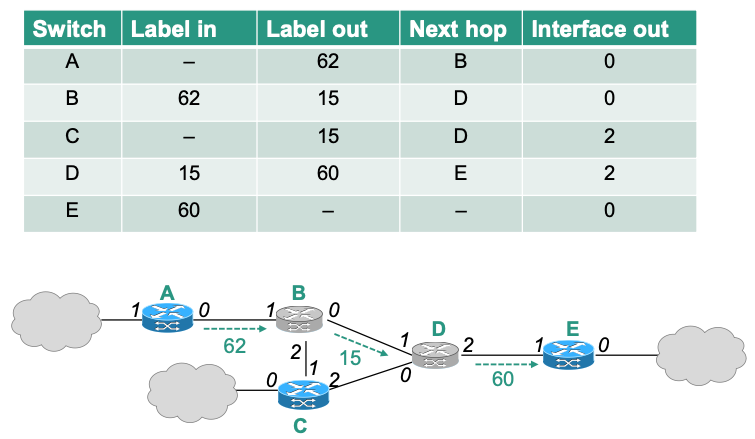
Multiprotocol Label Switching (MPLS)
General Aspects
MPLS
- Based on label switching
- Originally: data plane optimization
- Standardized within the IETF
- Increasingly applied in larger autonomous systems
- Main Features
- Fast forwarding (due to reduced amount of packet processing)
- QoS support
- Guarantees on latency and capacity, e.g., for voice traffic
- Traffic engineering
- Supports load balancing in order to optimize network utilization …
- Virtual private networks
- Isolate traffic from other packets on the Internet
- Multiple networks support
- Usable on different network technologies, e.g., IP, ATM …
👍 Advantages
- Clear separation of forwarding (label switching) and control (manipulation of label binding)
- Not limited to IP
- Support of metrics
- Versatile concept
- Scales
Architecture, Components and Basic Operation
Architecture
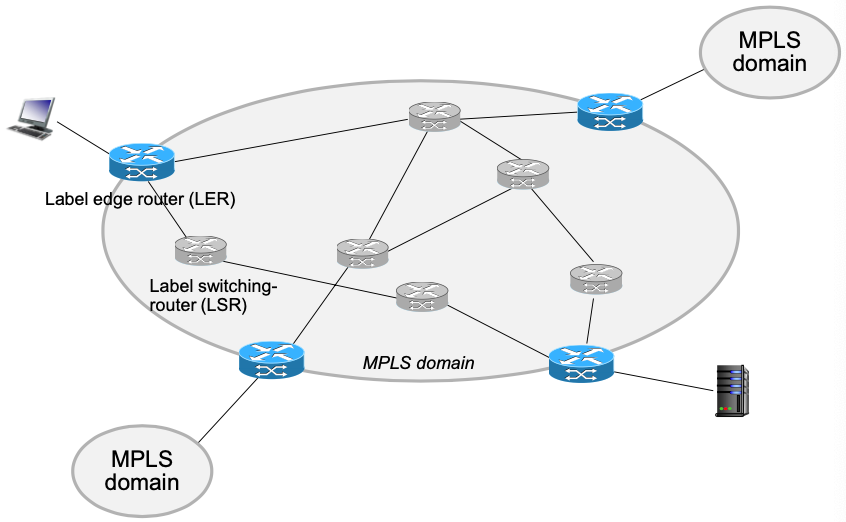
Components
Label-switching router (LSR)
MPLS-capable IP router
- Can forward packets based on both, IP prefixes and MPLS labels
- Typically: IP for control plane and MPLS for data plane
Architecture:
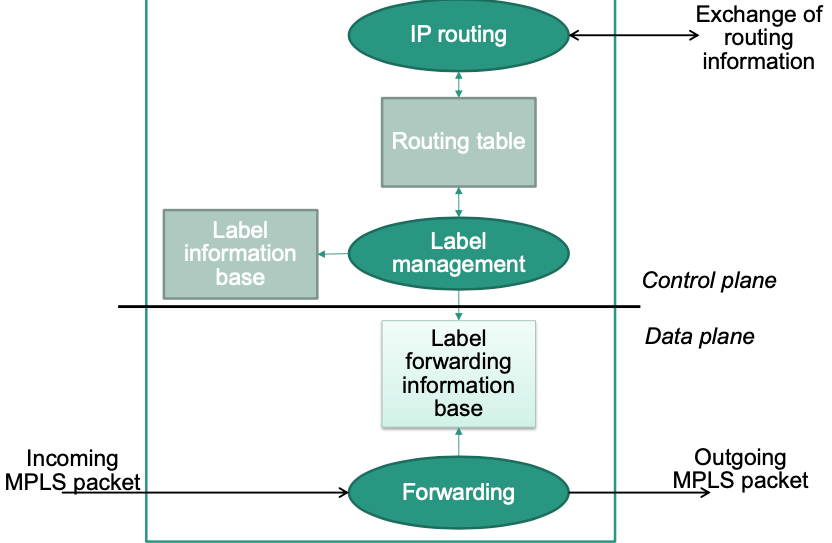
Label edge router (LER)
- Router at the edge of an MPLS domain
- Each LSR with a non-MPLS capable neighbor is an LER
- Also called: label ingress router resp. label egress router
- Classifies packets that enter the MPLS domain
- Router at the edge of an MPLS domain
MPLS-Node: General term for MPLS-capable intermediate systems, like LSRs
Forwarding Equivalence Classs
Class of packets that should be treated equally
Same path through the network
Same QoS properties
Basis for label assignment
MPLS-specific term, roughly comparable to „flow“
Example
Same address prefix and same type-of-service field
Same IP addresses and same port numbers
VoIP traffic with destination address in subnet X
Granularity
- Coarse-grained: Important for quick forwarding and scalability
- Fine-grained: Important for differentiated treatment of packets or flows
Example 1: Very fine granular FEC (“micro flow”)
A single TCP connection, identified by 5-tuple
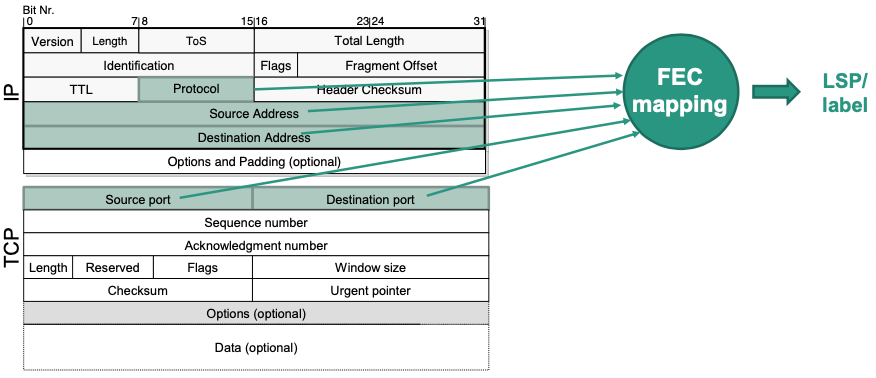
Example 2: data streams differentiation
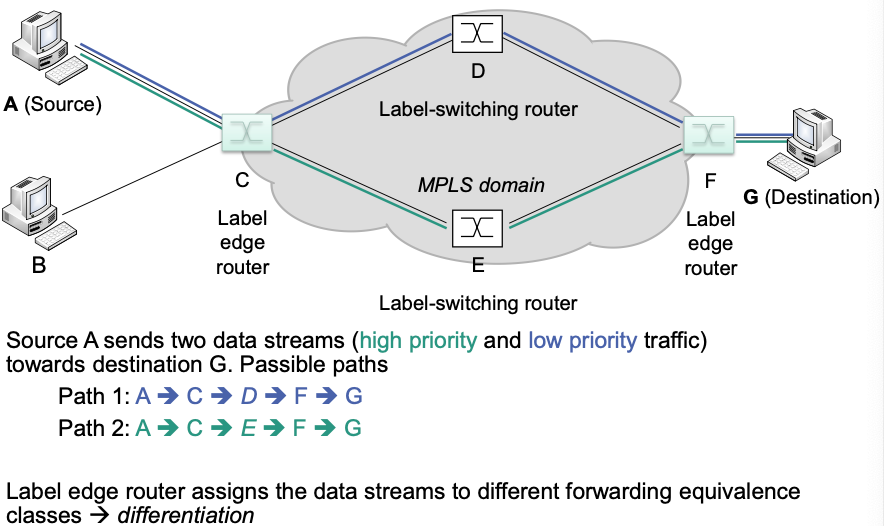
Traffic engineering
Usage of different paths
Goals
Load balancing
Utilization of all available resources
Prioritization of individual data streams
(realized through separate virtual connections)
Support of quality of service
Different quality of service for different data streams
Label Switched Path
Virtual connection: Sequence of labels on a path through MPLS domain.
Example:
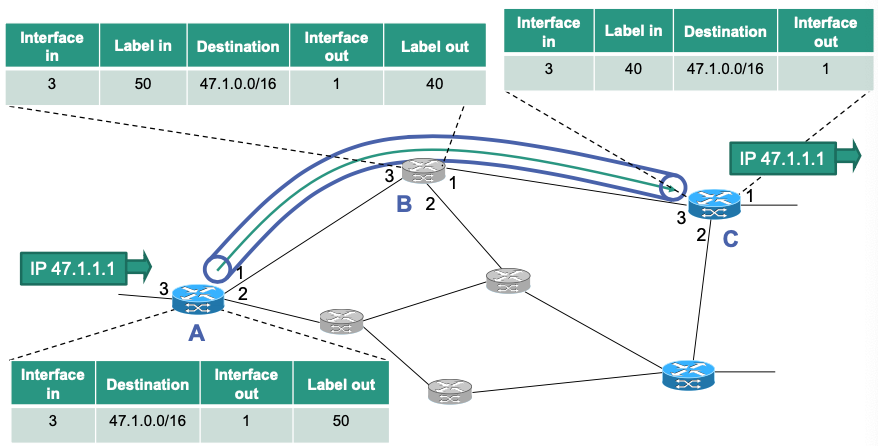
MPLS-Label
Encapsulation: Between headers of layer 2 (Data Link layer) and layer 3 (Network layer)

- Label: the label itself
- Exp: Bits for experimental usage
- S: Stack-bit
- TTL: Time-to-live
Label Distribution
Label Binding
- Associate specific label to FEC
- Stored in label forwarding information base
- Used as incoming label
Label distribution
- Label binding is distributed to neighboring routers
- Stored in label forwarding information base
- Used as outgoing label
Types of Label Distribution
“Roles” of a label-switching router

- Downstream LSR: In direction of data flow
- Upstream LSR: Against direction of data flow
Unsolicited downstream
- Router generates label bindings as soon as it is ready to forward MPLS packets of the respective FEC
- Upstream neighbors (according to IP routing): update forwarding tables
- Label used as outgoing label
- Non-upstream neighbors can store label for later use
- Quicker reactions on route changes
- Upstream neighbors (according to IP routing): update forwarding tables
- Router generates label bindings as soon as it is ready to forward MPLS packets of the respective FEC
Downstream on demand
- Downstream router generates label binding on demand
- Upstream router has to request label binding for FEC
Label Distribution Protocol
RSVP (Resource ReserVation Protocol)
🎯 Goal: bandwidth reservation for end-to-end data streams
Soft state principle
- Establish a session and periodically signal that session is still alive
- In case of failure state is automatically removed after some time
Signaling

- Path message
From sender to receiver
Find path to receiver
Each hop is recorded in the message
- Resv message
From receiver to sender
Bandwidth reservation on return path
- Path message
RSVP-TE (Traffic Engineering)
Extension to RSVP to support label distribution
- Many additional fields and functionality, e.g., fast reroute
Signaling

- Path message
- From upstream LER to downstream LER
- Label request
- Source route (“explicit route”) [optional]
- Resv message
In response to path message
From downstream LER to upstream LER
Label binding (hop-per-hop)
- Path message
Virtual Private Networks
- MPLS is useful for virtual private networks (VPNs)
- Use case: VPN traffic engineering
- Customer with sites at different locations (e.g., different cities) wants to lease seamless “network” service
- Requirements
Connect physically remote locations
Carry IP-based intranet traffic
Each customer has obtained an IP address block
Guaranteed bandwidth / SLAs
- Options
- “Dark fibre” provider
- VPN backbone provider
Example: Private Networks over “Dark Fibre”
Suppose that three companies have sites at remote locations
Company A: Karlsruhe, Paris, Zürich
Company B: Karlsruhe, Paris
Company C: Karlsruhe, Paris
Each company runs a private network
- Different subnet for each site from customers IP address space
- Router connects site to other site(s)
- Data is transported over leased fiber optic cables (“dark fibre”)
- Capacity 155 Mbit/s, utilization marked in graph

A provider uses MPLS to offer virtual private networks
Has „points of presence (PoP)“ in all three cities
Offers bandwidth at arbitrary rates
Is cheaper than leasing fiber optic cables
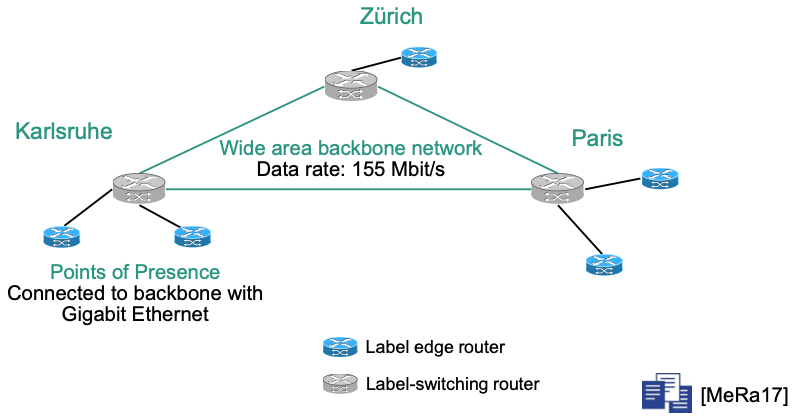
Question: Can the provider serve the need of all three companies?
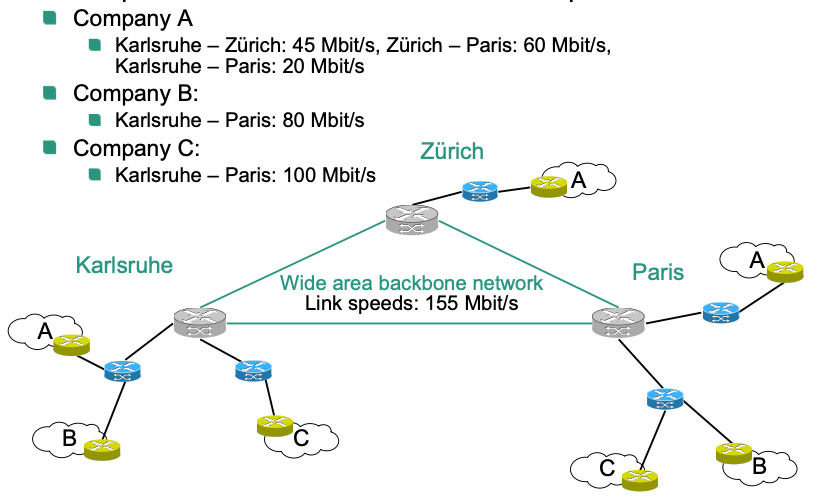
The answer is: YES! By utilizing non-shortest paths!
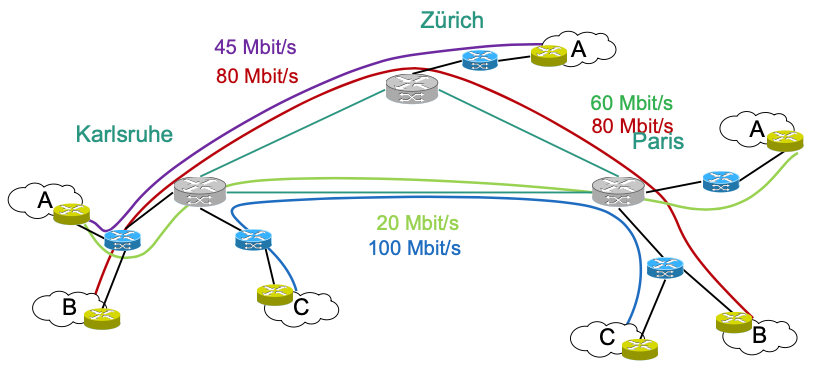
We can achieve that using VPNs implemented by Label Switching
Outer label: identifies path to LER
Inner label: identifies VPN instance / customer
For company A:
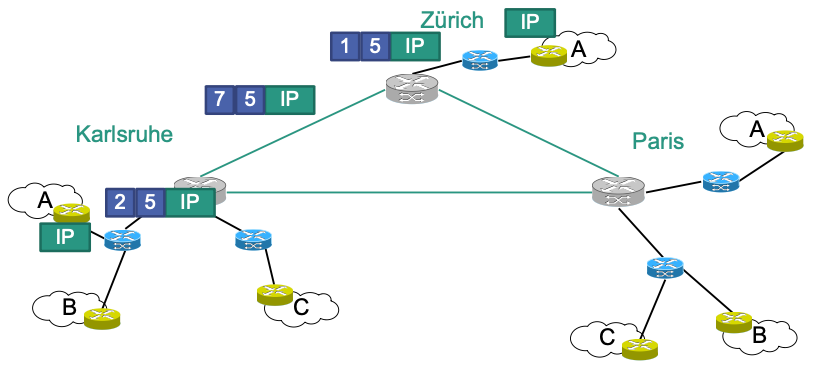
- Inner label : Indicates that this packet belongs to company A\
- Outer labels : Label switching/Swapping
For company B:
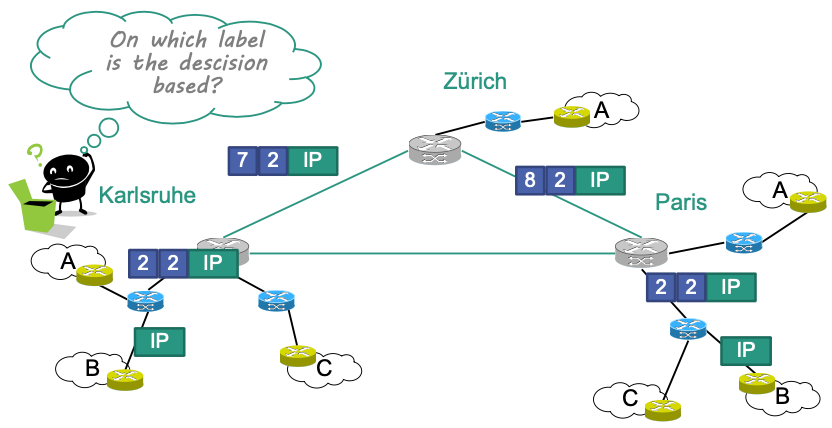
For company C:
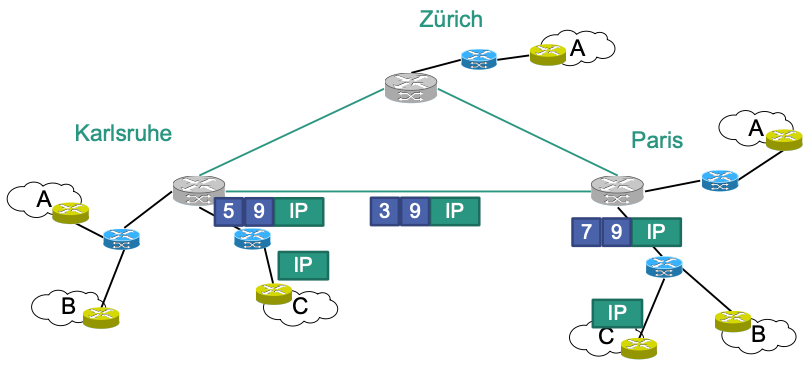
Label Distribution
Recall VPN example from above
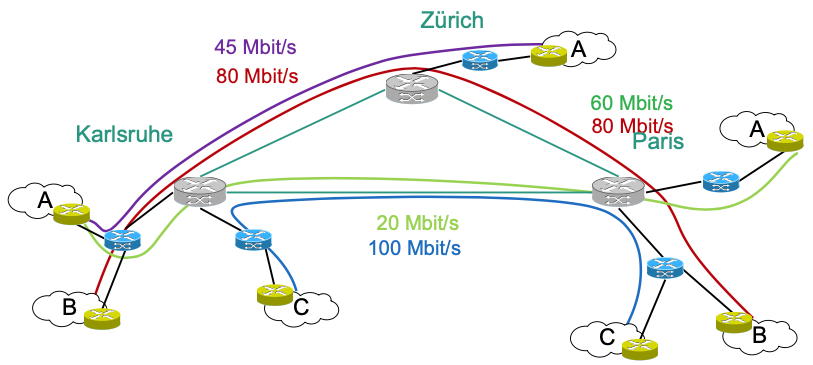
LSP for customer B (Karlsruhe Paris) should take a “detour” over Zürich) to match bandwidth requirements
Setup of LSPs over explicitly given route with RSVP-TE
- Example: LSP “Karlsruhe to Paris over Zürich”
- RSVP-TE signaling initiated at upstream LER (LER-KA)
- Note: LSPs are unidirectional!
- Example: LSP “Karlsruhe to Paris over Zürich”
How are the labels distributed?
LER-KA1 (upstream) sends Path Message to LER-P (downstream).
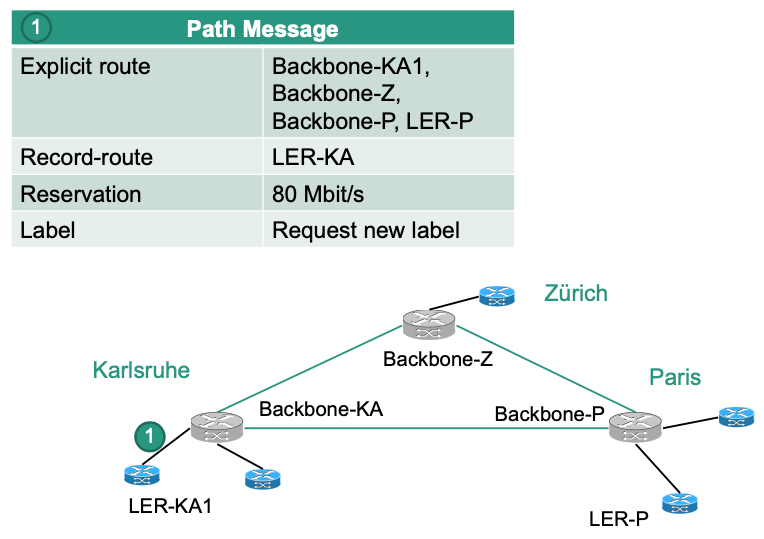
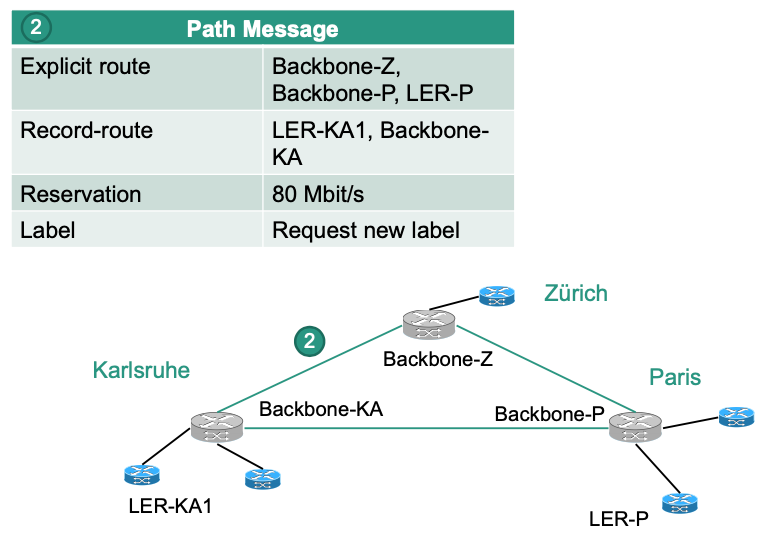

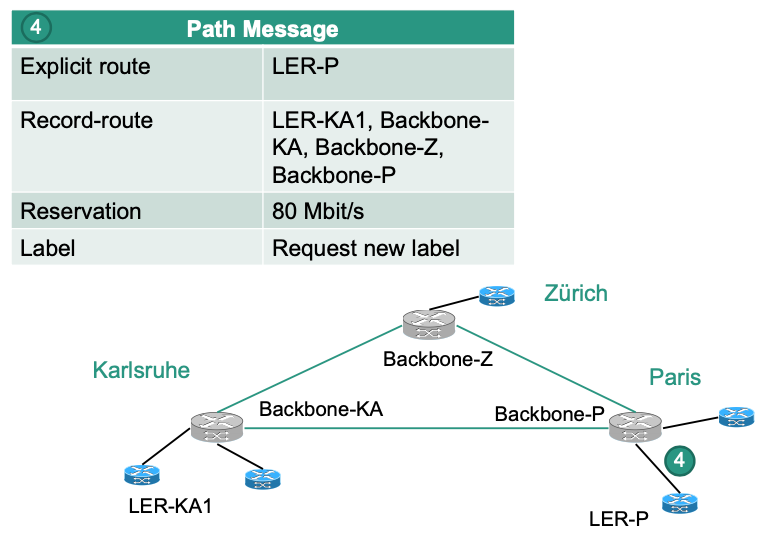
LER-P receives the Path Message and send Resv Message back.
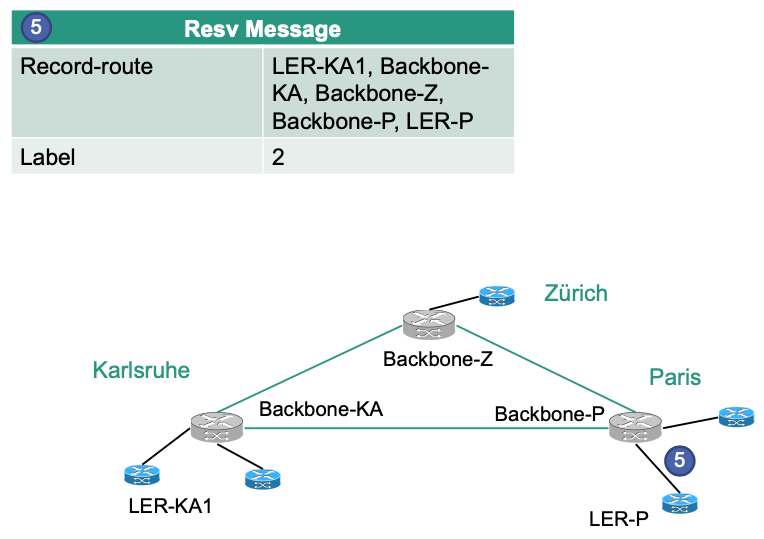
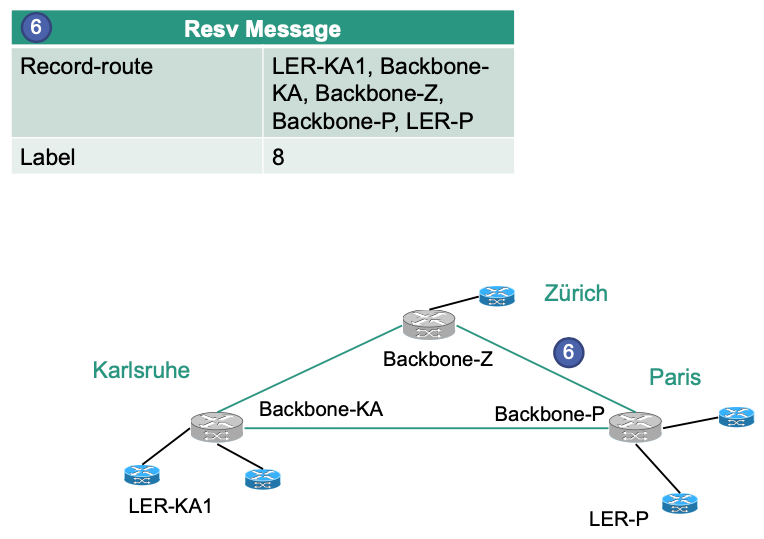
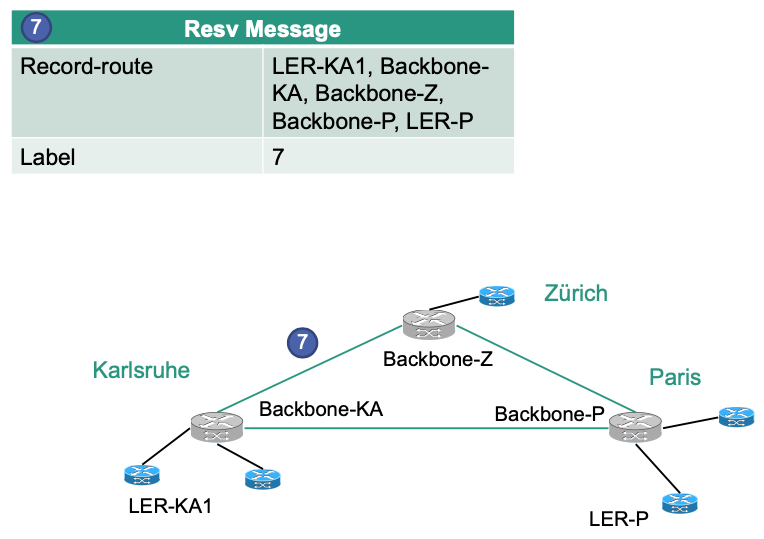
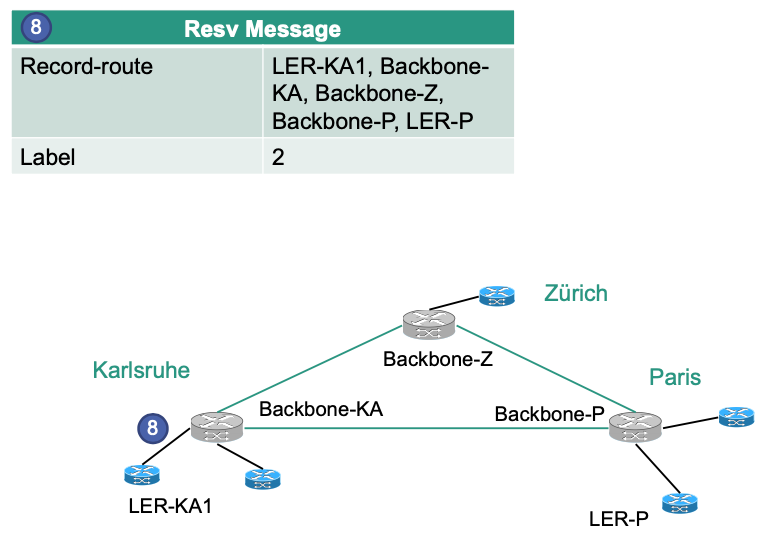
Resource
MPLS - Multiprotocol Label Switching (2.5 layer protocol)